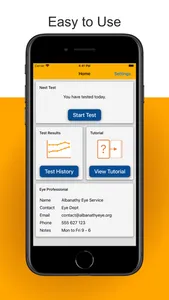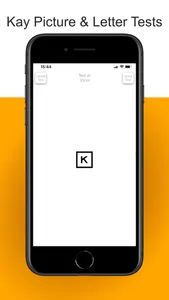The Kay Amblyopia Tracker app helps eye professionals and patients manage amblyopia better by monitoring vision changes at home between eye test appointments with a regular, simple-to-use test.
The test process is automated and quick to do at home without any expertise. Once you’ve read the tutorial, just follow the on-screen instructions.
The app displays the same letters and familiar pictures seen in a professional vision test, but with a unique testing process that is easy to use at home for children from 24 months of age.
This test process has been shown to provide accurate results comparable with a standard test of visual acuity *. The test results from using the app are intended to monitor the progress of amblyopia when viewed over time.
The Amblyopia Tracker app does not diagnose vision defects. It offers a simple method for monitoring changes in a child’s vision responses between eye clinic appointments that can provide useful information for amblyopia patients and their eye professional (orthoptist, optometrist or ophthalmologist).
The app can only be accessed through a qualified eye professional, ensuring that a diagnosis and treatment plan are in place and ongoing. The Amblyopia Tracker app should only be used to test the individual who has been prescribed this monitoring device.
Regular home test scores are automatically uploaded to a chart at the end of each completed test process, making it easy to follow the child’s progress and giving useful feedback and encouragement.
For patients:
- Provides a fun, easy way to keep track of changes and improvements in your child’s amblyopia at home.
- Displays the same familiar letters and pictures used for clinical vision testing.
- Tests vision with an automated system and records the information in a simple chart format.
- Gives you and your child a visual chart of their progress to encourage compliance with treatment.
- Displays contact details for your child’s eye professional and an email link to them from the Test History Chart.
- Tells you when you last tested and can be set to remind you when to test next.
For eye professionals:
- The app is configured to accurately display letter and picture optotypes that are validated for visual acuity measurement.
- Vision tests and scores are repeated regularly to iron out expected small subjective variations over time.
- Results automatically upload to a progress chart format in the app for easy patient understanding.
- Measurement results are not given as a visual acuity score, ensuring no treatment decisions could be taken by the patient.
- Access to the app test process is via activation codes provided only to qualified eye professionals and medical personnel.
- Regular home testing and monitoring can aid patient understanding and compliance with treatment.
- The progress chart can be shared with you and may help you to decide on the frequency of follow up appointments.
* Reference O’Connor, A., Waters, M., England, L., Milling, A. and Kay, H., 2021. Evaluation of a New Method to Track Changes in Vision at Home for Children Undergoing Amblyopia Treatment. British and Irish Orthoptic Journal, 17(1), pp.70–78. DOI: http://doi.org/10.22599/bioj.172
The test process is automated and quick to do at home without any expertise. Once you’ve read the tutorial, just follow the on-screen instructions.
The app displays the same letters and familiar pictures seen in a professional vision test, but with a unique testing process that is easy to use at home for children from 24 months of age.
This test process has been shown to provide accurate results comparable with a standard test of visual acuity *. The test results from using the app are intended to monitor the progress of amblyopia when viewed over time.
The Amblyopia Tracker app does not diagnose vision defects. It offers a simple method for monitoring changes in a child’s vision responses between eye clinic appointments that can provide useful information for amblyopia patients and their eye professional (orthoptist, optometrist or ophthalmologist).
The app can only be accessed through a qualified eye professional, ensuring that a diagnosis and treatment plan are in place and ongoing. The Amblyopia Tracker app should only be used to test the individual who has been prescribed this monitoring device.
Regular home test scores are automatically uploaded to a chart at the end of each completed test process, making it easy to follow the child’s progress and giving useful feedback and encouragement.
For patients:
- Provides a fun, easy way to keep track of changes and improvements in your child’s amblyopia at home.
- Displays the same familiar letters and pictures used for clinical vision testing.
- Tests vision with an automated system and records the information in a simple chart format.
- Gives you and your child a visual chart of their progress to encourage compliance with treatment.
- Displays contact details for your child’s eye professional and an email link to them from the Test History Chart.
- Tells you when you last tested and can be set to remind you when to test next.
For eye professionals:
- The app is configured to accurately display letter and picture optotypes that are validated for visual acuity measurement.
- Vision tests and scores are repeated regularly to iron out expected small subjective variations over time.
- Results automatically upload to a progress chart format in the app for easy patient understanding.
- Measurement results are not given as a visual acuity score, ensuring no treatment decisions could be taken by the patient.
- Access to the app test process is via activation codes provided only to qualified eye professionals and medical personnel.
- Regular home testing and monitoring can aid patient understanding and compliance with treatment.
- The progress chart can be shared with you and may help you to decide on the frequency of follow up appointments.
* Reference O’Connor, A., Waters, M., England, L., Milling, A. and Kay, H., 2021. Evaluation of a New Method to Track Changes in Vision at Home for Children Undergoing Amblyopia Treatment. British and Irish Orthoptic Journal, 17(1), pp.70–78. DOI: http://doi.org/10.22599/bioj.172
Show More




